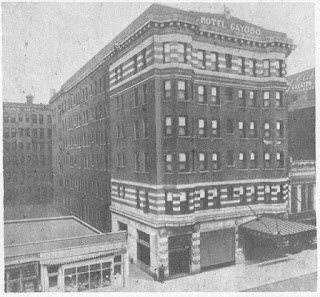A vision of grandeur for the developing river metropolis at Memphis, the Gayoso House was built by Robertson Topp, a wealthy young planter. Topp was involved in the development of South Memphis, an area of houses, commercial buildings, and a hotel designed to grace the young city with high architectural style. He commissioned James Dakin, a founder of the American Institute of Architects, to design the structure, which was constructed in 1842. Its Greek Revival portico was easily recognizable from the river. In the late 1850s Topp continued his efforts to bring architectural distinction to Memphis, when the Cincinnati firm of Isaiah Rogers, designer of the Tremont House in Boston, contributed to an addition that almost doubled the Gayoso's original 150 rooms. The addition featured wrought-iron balconies overlooking the Mississippi; the supervising architect was James B. Cook, an Englishman who stayed in Memphis for the rest of his architectural career.
The Gayoso House became a Memphis landmark, an oasis of modern luxury frequented by travelers passing through the city by river, road, or rail. With its own waterworks, gasworks, bakeries, wine cellar, and sewer system, the hotel offered amenities far beyond those available to the rest of Memphis. The indoor plumbing included marble tubs and silver faucets as well as flush toilets.
The Gayoso House burned on July 4, 1899. To replace it, James B. Cook designed a new hotel. His U-shaped construction surrounded a courtyard screened from Front Street by a row of columns, which are no longer extant. Goldsmith's department store bought the hotel in 1948 and used it for offices and storage. Fifty years later, however, it was restored for use as downtown apartments, residences, restaurants, and offices.
Hotel Gayoso, Memphis TN - 1942 deco postcard and 1930's postcards
Source: tennesseeencyclopedia.com


